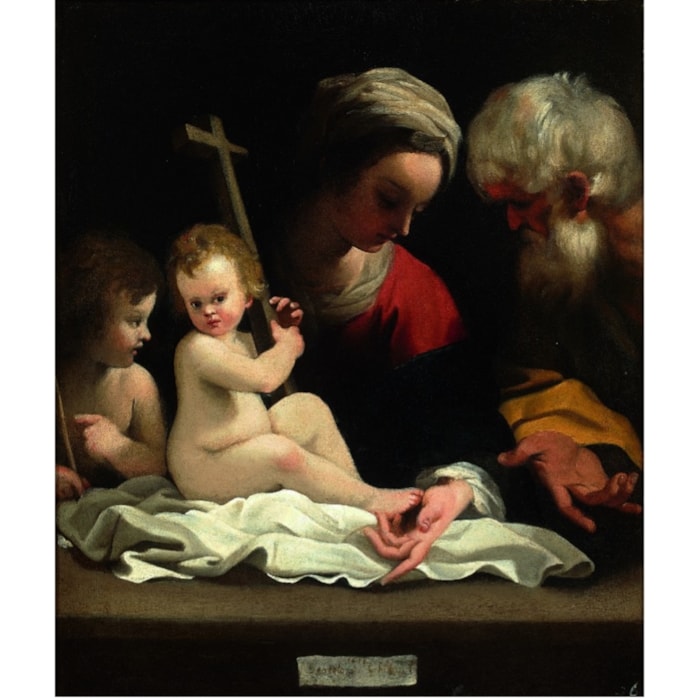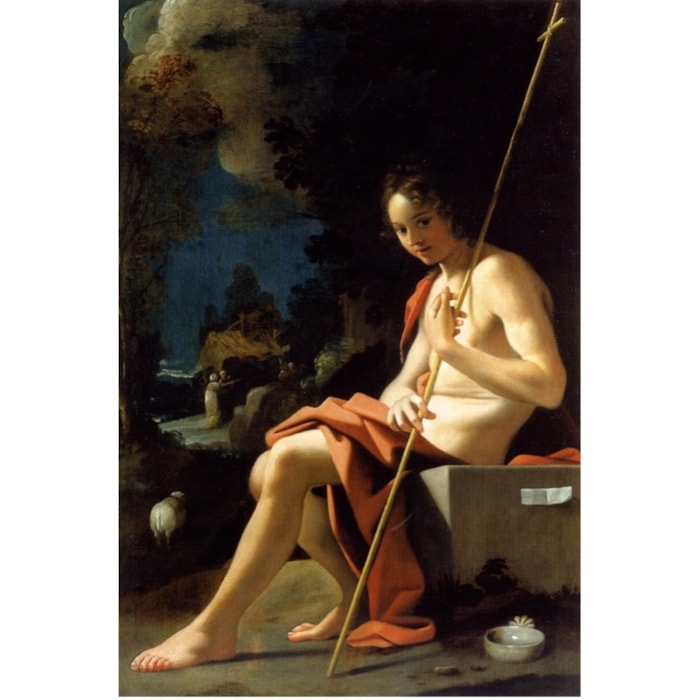Bartolomeo Schedoni (Modena, 1578 - Parma, 1615)
(Modena, 1578 - Parma, 1615)
The Holy Family with the Young Saint John the BaptistOil on wood panel, 11 1⁄2 x 9 3⁄4 in (29.1 x 24.7 cm). Signed “Bartolomeo Schedoni” on the cartellino at lower right
- PROVENANCE
- LITERATURE
- EXHIBITIONS
- DESCRIPTION
PROVENANCE
Probably Parma, Farnese collection, at least since 1734/1739. Acquired by Franz Anton Boner (1868-1941) at the beginning of the twentieth century; by descent to the current owners.
LITERATURE
Unpublished
DESCRIPTION
This Holy Family is a painting of the highest quality, particularly in the soft handling of drapery and hair: the golden blond locks of the Christ Child, those of the young Baptist, with reddish touches, and the white, fluffy hair of Joseph. The flesh passages are no less delicate, their tonal modulation ranging from the opalescent paleness of the areas more exposed to light to the warmer, rosier tones of the areas in half-shadow. The Virgin’s turban, in particular, is a perfect example of the painter’s masterly talent: the freshness of the brushstrokes is still clearly distinguishable, revealing his skill in rendering every passage of light on the rolled fabric.
The composition is crowded and narrow, with the pictorial space almost completely occupied by the figures, conveying a profound intimacy that culminates in the sweetest of gestures: the Child’s little hand caressing his mother’s neck, which exactly occupies the centre of the scene. Touches of contrasting light fall on the profile of the young Baptist and the forehead and nose of the Madonna, and only the Child is completely immersed in luminosity. The authorship of the painting is confirmed by the signature “Bartolomeo Schedoni” on a trompe-l’oeil cartellino at lower right corner.
The work dates to Schedoni’s second sojourn in Parma at the court of Prince Ranuccio Farnese. Since 1607 he had been in the service of the Duke of Parma and Piacenza with an exclusive contract: he must not work for any other patron, unless expressly authorized by the Prince himself. Consequently, Schedoni’s works from this period have in most cases formed part of the Farnese collections.
Thanks to the studies of Alberto Crispo, we know that an inventory drawn up in 1734 of the “appartamento dei quadri” in the Ducal Palace in Parma records a painting by Schedoni that coincides in subject and, even more significantly, in support (“assa”, or wood panel) and dimensions with the work presented here: “del Schedoni sull’assa / Altro quadro come s.a alto on. 6 ½ largo on. 5 ¼ [i.e., 29.5 x 24 cm]. Il Bambino Gesù La Vergine, S. Gio. Batt.a, e S. Giuseppe”1. The scholar was then able to verify that the same panel appears five years later, in July 1739, in the list of paintings chosen by the Farnese heir, Charles of Bourbon, to be sent to Naples, the capital of his new kingdom2. The charming iconography of this Holy Family had greatly appealed to the patron, Ranuccio Farnese, and indeed early inventories testify to the presence of another painting – now lost – with the same detail of the caress on Mary’s neck, but larger in size (and almost certainly on canvas).
Our panel, probably identifiable as the one listed in the mid-eighteenth century among the Farnese works shipped to Naples, belonged at the beginning of the twentieth century to the banker Franz Anton Boner (1868-1941), who was president of the Bremer Kunstverein, the cultural association through which the Kunsthalle Bremen was founded, from 1918 to 1922. A passionate collector, he was advised by important art historians including Max Friedländer, Gustav Pauli, director of the Kunsthallen of Bremen and Hamburg, and August L. Mayer, curator of the Munich picture gallery.
The panel studied here is notable not only for its quality but also for the presence of the signature which was found to be original and free of repainting during recent conservation.
The only other such work is a painting which reappeared in 2017 in Paris3, also originally in the Farnese collections4, with a scroll at the bottom inscribed “1613 / Bartolomeo Schedoni F” (fig. 1).
Already at the end of the eighteenth century the painting was in poor condition, and the inscription has now been strengthened5. A beautiful Saint John the Baptist (private collection) also has a cartellino that probably originally bore the painter’s signature, but no trace remains today (fig. 2).
The composition of our Holy Family was already much appreciated early on6. Among the various versions, many of which are copies of mediocre or even very poor quality, there are two whose authorship has not been questioned by scholars: one, larger in size than ours, now in the Hermitage in Saint Petersburg (oil on panel transferred to canvas, 67.7x50 cm, inv. ГЭ-4058) and another on panel (46x37 cm) in the Fondazione Galleria Rizzi in Sestri Levante. A version on canvas, formerly in the Campori collection and now in the Musei Civici, Modena, has been downgraded by recent scholarship to workshop status. It is also worth mentioning the canvas in the Alte Pinakothek, Munich, considered by Crispo to be of the lowest quality among those mentioned here.
Bartolomeo Schedoni was born in Modena, where he was baptised on 13 January 1578. There are no documents regarding his education, but we know that he was in Parma in 1594, together with his father, at the Farnese court. In the same year, through the good offices of Duke Ranuccio I, he was sent to Rome to learn the art of painting at the Accademia di San Luca, which was directed at that time by Federico Zuccari. In March 1597 he was once again in the service of the Duke of Parma as a painter. In the following years he worked in Reggio Emilia, Parma and Modena for the Este and Farnese families, whose courts were also closely linked through the mutual exchange of artists. In this period Schedoni was also employed to copy and restore Correggio’s altarpieces and frescoes in the churches of Modena, Reggio and Parma, with a profound absorption of the earlier artist’s legacy of naturalism.
From 1600 onward, Schedoni was in trouble with the law, facing arrest7 and in 1606 having to flee from Modena, where he had been engaged on decorating the principal room of the city hall. On 1 December 1607, as mentioned earlier, he began working for Ranuccio I Farnese. The contract signed with the Duke of Parma guaranteed him a substantial salary, allowed him to avail himself of the collaboration of his brothers (decorators and gilders) and obliged him not to accept further commissions from other clients without the approval of the court. In these years Schedoni was influenced by the Carracci, Guido Reni, Caravaggio and the sculptor Francesco Mochi, who was also active for the Farnese family. Ranuccio himself chose a bride for the painter, the daughter of the Ducal estate manager Paolo, and on the occasion of their wedding in 1613 he gave the couple the tenure of some pieces of property in the Parma area. In 1614 Schedoni completed two of his most celebrated works, the Entombment of Christ and The Maries at the tomb (both Parma, Galleria Nazionale), large horizontal canvases painted for the Capuchin convent of Fontevivo (between Parma and Fidenza), financed by Ranuccio Farnese. The extensive decorative project for the rooms of this conventual complex remained unfinished following Schedoni’s death in December 1615.
Notes:
[1] Inventario dell’appartamento chiamato l’appartamento de quadri nel Pallazzo Ducale di Parma, 1734, Naples, Archivio di Stato, Archivio Farnesiano, b. 1853, III, vol. XI, inv. 6. Published in G. Bertini, La Galleria del Duca di Parma. Storia di una Collezione, Parma 1987, p. 297.
[2] “Quadro piccolo in cornice come sopra, alto once 6 ½, largo once 5 ½ - / Schedoni: il Bambino Gesù, la Vergine, S. Giovanni Battista e S. Giuseppe”, in Inventario de’ quadro levati in corte S.A. Reale dall’Appartamento chiamato l’Appartamento de’ Quadri, parte de’ quali si sono rotollati e parte con sue cornici dorate incassati, con altro piccolo inventario de’ dodici Imperadori levati dall’Appartamento in cui abitava S.A. Reale in Parma. In Marzo 1734; Nota de Quadri da mandarsi in Napoli in Napoli, e spediti per barca nel mese di Luglio 1739 per ordine del Signor Duca Ministro, ms. 1734-1739, Naples, Archivio di Stato, Archivio Farnesiano, busta 1853 (III), vol. XI, Inv. 8, cc. 1-20, published in F. Strazzullo, Le manifatture d’arte di Carlo di Borbone, Naples 1979, p. 74, no. 151.
[3] The painting appeared at Artcurial in Paris on 23 March 2017, lot 122 (oil on panel, transferred to canvas, 54x45 cm). The inscription has been reinforced and the inventory number “54” at lower right reworked (the final figure 4 thus becoming a 6).
[4] “Quadro senza cornice alto br.a uno, largo onc.e dieci. Una Madonna in atto di parlare con S. Giuseppe. Il Bambino in grembo con croce in mano, e di dietro S. Gio. Batt.a con iscrizione in fondo ‘1613 Bartolomeo Schedoni’, Del Schedoni n. 54”, in the 1708 inventory, published in G. Bertini, La Galleria del Duca di Parma. Storia di una Collezione, Parma 1987, p. 186, no. 294. The picture already appears among the works in the Apartment of Princess Maria Maddalena in 1693: “Mad.a con bamb.o S. Gio. Batt.a, e S. Giuseppe in corn.e dor.a gran.a del Schedone n° 54” (ibid., p. 278).
[5] In 1783 Tommaso Puccini, the director of the Florentine Galleries for the Grand Duke of Tuscany, wrote that the painting “is so ruined, so botched, that it needs very close study in order to be enjoyed”: see M.C. Mazzi, “Tommaso Puccini: un provinciale ‘cosmopolita’”, Bollettino d’arte, s. VI, LXXI, 1986, 37-38, p. 23.
[6] For comparison and a list of known versions, see F. Dallasta, C. Cecchinelli, Bartolomeo Schedoni pittore emiliano, Parma and Colorno 1999, pp. 161-164, no. 62; and E. Negro, N Roio, Bartolomeo Schedoni pittore e scultore, Modena 2002, p. 83, no. 27.
[7] We know of a first arrest in 1600, when Schedoni was detained for having ambushed a man who had pestered a friend of his, the prostitute Giulia de Rossi (F. Dallasta, “Il pennello e il pugnale. Il pittore Bartolomeo Schedoni arrestato a Parma nel marzo del 1600”, Aurea Parma, XCIX (2015), 1, pp. 73-106). The painter was arrested again in 1606 is connection with acts of violence, but the details remain unknown.











